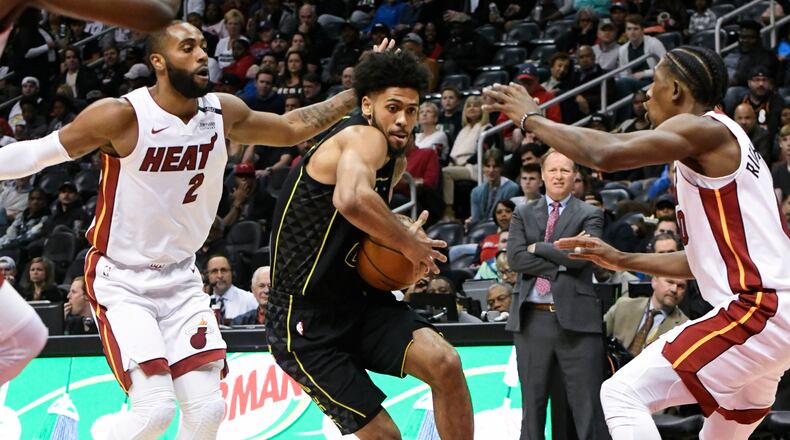Following a poor showing at summer league, Hawks second-round pick Tyler Dorsey played a total of 51 minutes over the first 11 games and few of them were meaningful. After stints in the G League, Dorsey rejoined the Hawks for good in January and ultimately cracked Mike Budenholzer’s rotation.
Long-range shooting was Dorsey's NBA-ready skill out of Oregon and that's where he made the most impact as a rookie. More than half of his Dorsey's shot attempts this season were 3's and he made 36.2 percent, matching the average accuracy for all NBA players.
Per Synergy Sports, Dorsey shot posted a 53.2 effective field-goal percentage on 124 catch-and-shoot jumpers and a 46.2 eFG% on 92 shots off the dribble. Those are efficient numbers for those play types but Dorsey’s 39.3 percent shooting overall on two-pointers was sixth-worst among 48 rookies who played at least 500 minutes and his free-throw attempt ranked 34th.
Before the season, Hawks GM Travis Schlenk said Dorsey has the potential to be a secondary ball-handler. Dorsey ended up filling that role—as well as playing roughly 88 minutes at point guard per Basketball Reference—and 23 percent of Dorsey’s possessions used came as the pick-and-roll ball-handler. Dorsey’s assist to usage ratio ranked in the 11th percentile among combo guards, according to Cleaning the Glass, but he also hardly ever committed turnovers (37 total for the season).
Defensively, Dorsey offered very little production in steals and block and the Hawks allowed 1.6 more points per 100 possessions with him on the court overall. CTG filters out garbage time and has the Hawks allowing 0.7 points per 100 possessions more with Dorsey on the court. Former Hawks coach Mike Budenholzer said coaches worked with Dorsey on his defensive toughness and competitiveness throughout the season and saw improvement in those areas by the end.
Dorsey was surprisingly effective as a defensive rebounder, ranking in the 75th percentile among combo guards per Cleaning the Glass (non-garbage time). Opponent offensive rebounding percentage was six percent lower with Dorsey on the floor vs. off. Some of that likely can be attributed to Dorsey sharing the court with Dewayne Dedmon for 40 percent of his non-garbage time possessions but I thought Dorsey had very good awareness on the boards while producing 4.2 defensive rebounds per 36 minutes.
Dorsey showed flashes of his potential as a catch-and-shoot combo guard when the Hawks leaned heavily on their young players over the final two months of the season. He has a guaranteed contract for next season but, after being buried on the depth chart to begin his rookie year, Dorsey could have to fight for playing time again.
Two of the veterans ahead of Dorsey have since departed (Marco Belinelli and Luke Babbitt) and combo guard Malcolm Delaney is eligible to become a free agent. But two wing prospects the Hawks added this season, Antonius Cleveland and Jaylen Morris, have non-guaranteed deals for 2018-19. DeAndre’ Bembry also is under contract for next season and the Hawks could add more wings via the draft.
Defensive rebounding and 3-point shooting were the positive aspects of Dorsey’s rookie season. To stick in the NBA after next season, Dorsey likely will have to improve his efficiency on two-point shots, become a better secondary play-maker and figure out how to hold his own defensively in spite of his relatively slight frame and short wingspan.
About the Author
Keep Reading
The Latest
Featured



